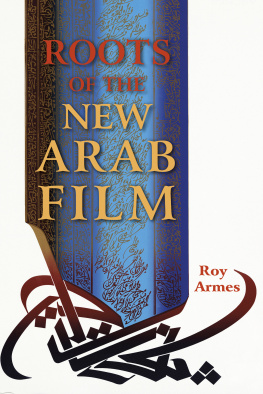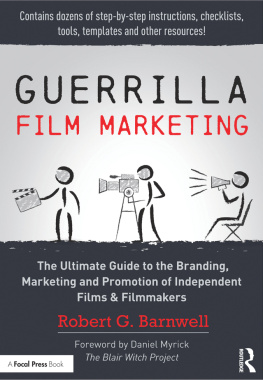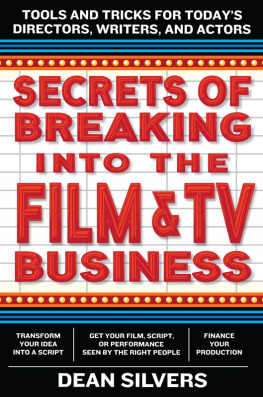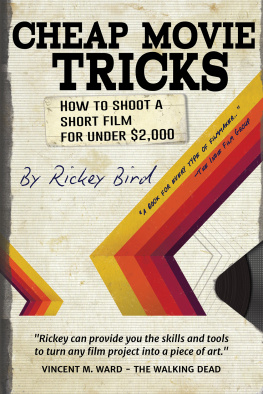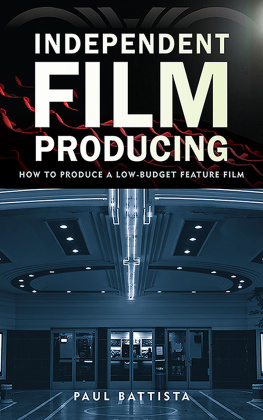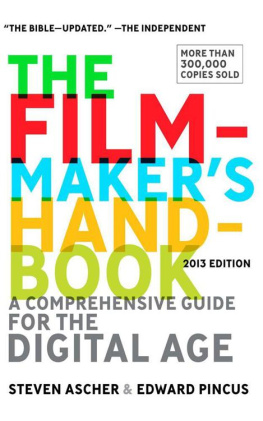
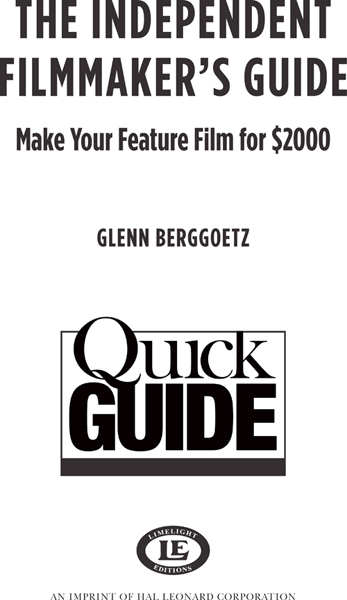
Copyright 2012 by Glenn Berggoetz
All rights reserved. No part of this book may be reproduced in any form, without written permission, except by a newspaper or magazine reviewer who wishes to quote brief passages in connection with a review.
Published in 2012 by Limelight Editions
An Imprint of Hal Leonard Corporation
7777 West Bluemound Road
Milwaukee, WI 53213
Trade Book Division Editorial Offices
33 Plymouth St., Montclair, NJ 07042
Book design by Mark Lerner
Library of Congress Cataloging-in-Publication Data
Berggoetz, Glenn.
The independent filmmakers guide: make your feature film for $2000 / Glenn Berggoetz.
p. cm.
1. Motion picturesProduction and direction. 2. Low budget films. I. Title.
PN1995.9.P7B365 2012
791.430232dc23
2012025304
www.limelighteditions.com
To Diane HenryThank you for being you
Contents
Ive heard it and read it dozens of timesit takes tens of thousands of dollars and years of hard work to make a feature film. Both claims are completely not true, and Im living proof of that. While you certainly can spend your life savings and max out every credit card you can get your hands on, and spend three, four, or even five years making your film, you can also spend $1100 and four months making a feature film, as I did when I made The Worst Movie EVER!
The film world is constantly changing. Fifteen years ago, when making a film meant buying and developing copious amounts of actual film, filmmakers were pretty much left with no alternative but to spend an absolute minimum of $20,000 to make a feature. But with the advent of digital film and digital cameras, and with the ability to now record your film almost directly into a computer, those days are gone. No longer must a filmmaker invest a small fortune into film alone.
But what about paying a cast and crew? That can come a lot cheaper than you think. There are so many hungry actors, actresses, camera people, and sound people out there who will do just about anything to work on a film that its quite easy to find competent, sometimes exceedingly talented, people to work on your films for gas money and some free food.
I have made many films over the last five years, some shorts, but mostly features. My feature films Therapissed, Separate Checks, and Evil Intent quickly landed distribution deals. My feature film To Die is Hard won a Golden Ace Award and received a theatrical release. My feature film The Worst Movie EVER! also got a theatrical release, both in the United States and in Europe, and has a worldwide distribution deal. How much did it cost me to make these five feature films? Seventy-seven hundred dollars. Total. Thats right, $7700, for an average of $1540 per film. Entertaining films can be made on a shoestring budget.
Did I go to film school? No. All I really wanted to be was a scriptwriter. At 38 years old, I had spent nearly a decade writing scripts on the side, and eventually I had nine completed feature film scripts. Could I get anyone in Hollywood to take a look at them? No.
So one day, while living in Denver, Colorado, I spoke with a guy who used to work in Hollywood and told him about my scripts. He suggested that the best way to break into Hollywood would be to make my own films, and that if I did it well, Id get noticed.
From there I read a couple of books on filmmaking and directing. It was a bit overwhelming. The books on filmmaking made making a film seem like a Herculean task, that to make a film was a talent reserved for the gods, that mere mortals shouldnt even deign to undertake such an endeavor. But such was my mania to make a film that I pressed on.
I decided to start by making a short film. The film was titled Bad Movies, Good Showers, and Civil Engineers. It was a simple film that followed the conversations simultaneously taking place at four tables in a restaurant. I figured it would be wise to do something simple as I learned the process.
One of the first obstacles I faced was that the script was 22 pages long, but over and over in the books I read, I came across the thought that to shoot even five pages of script in a single day was quite remarkable, and I planned to shoot the entire film in one day. A few people told me I was biting off more than I could chew, but I thought, How difficult can it be to film people talking? So I pressed on.
The day of the shoot arrived, and we arrived on set at 7 a.m. that day. Things went smoothly as I frequently let the more veteran cast and crew members do their thing. The shooting went quickly. And I began to notice some things. I noticed that there was plenty of natural light flooding the set, and that we didnt really need a lighting technicianall we needed was maybe one or two lamps or reading lights to fill in some shadows. (Shadows in a scene are typically considered taboo to many filmmakers, camera people, and lighting technicians because they are seen as being amateurish when they appear in a film, but who cares about shadows? Life is filled with shadows!) I noticed we didnt really need a sound guy with lots of elaborate equipment, that all we really needed was anyone who could hold a boom microphone. I realized I didnt need a director of photography and two additional camera people, that we could have gotten by with the DP working a camera and one other cameraperson. I realized I didnt need to put so much time and money into making sure there was plenty of food to eat, because most cast members were only on set for a little while, and most crew members are happy with cookies and potato chips (the healthy foods I brought to the set went almost completely untouched). And I realized that the shoot was flying bywe shot all 22 pages by 4 p.m.
I also quickly realized that much of the information I had read in books on filmmaking was useless (you dont need to know what a gaffer, second assistant director, and line producer do), that the books could have been whittled down from 400 and 500 pages to about 50-100 pages. So often filmmakers get caught up in so much useless minutiae in shooting their film that the film suffers, the shoot drags on, the cast and crew gets cranky, and the bank account dwindles. None of this is necessary.
Over the course of the next six months I made two more short films to familiarize myself with the filmmaking process. All the while I was working on feature scripts that would be easy to shoot, and seven months after making my first short film, I embarked on shooting my first feature film.
While on the topic of short films, let me point out now that short films are primarily masturbatory exercises. For the most part, theyre only good for learning how to make feature films. In very, very rare instances, a short film might be so good as to end up being a filmmakers big break, but the other 99.99% of the time, there are so many people making so many short films and showing them in so many film festivals where there is not one person in attendance who can do anything to make or break your career that the making of the short film is nothing more than an opportunity to practice your craft a bit. Short films arent going to get a DVD release, theyre not going to be shown in theaters (with very rare exceptions), theyre not going to get shown by a television network (again, with very rare exceptions), and youre not going to be able to sell them in the foreign markets, so dont waste your time making short films, make features.
Next page

